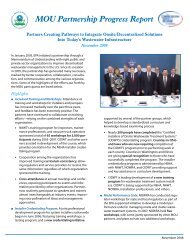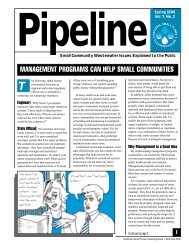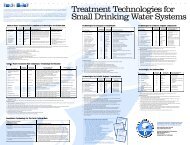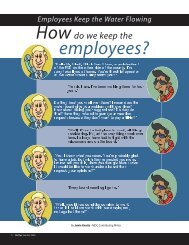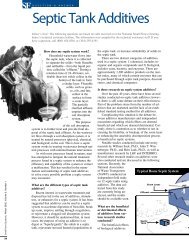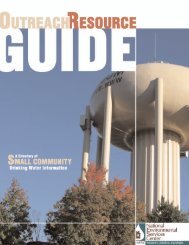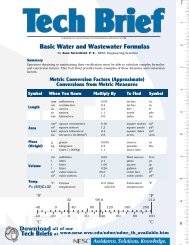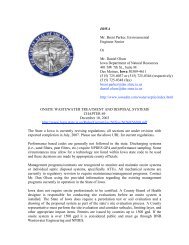Are Small Community Water Systems More at Risk than Other ...
Are Small Community Water Systems More at Risk than Other ...
Are Small Community Water Systems More at Risk than Other ...
You also want an ePaper? Increase the reach of your titles
YUMPU automatically turns print PDFs into web optimized ePapers that Google loves.
10,000, approxim<strong>at</strong>ely 20 percent<br />
felt th<strong>at</strong> r<strong>at</strong>es did not cover costs,<br />
and 25 percent of those representing<br />
systems of more <strong>than</strong><br />
10,000 felt the same way. Again,<br />
it is possible to interpret this as a<br />
sign of low capacity, as small systems<br />
may simply not have<br />
understood the extent to which<br />
their system was in difficult financial<br />
straits. This could explain<br />
some of the other responses.<br />
When we asked for more<br />
objective indic<strong>at</strong>ors of capacity, a<br />
more definite p<strong>at</strong>tern emerged.<br />
<strong>Systems</strong> of gre<strong>at</strong>er <strong>than</strong> 10,000<br />
connections were significantly<br />
less likely to have been cited<br />
with viol<strong>at</strong>ions in the last two<br />
years. <strong>Systems</strong> of fewer <strong>than</strong> 500<br />
hookups were significantly more<br />
likely <strong>than</strong> systems in all other<br />
size c<strong>at</strong>egories to have had w<strong>at</strong>er<br />
quality viol<strong>at</strong>ions over the last<br />
two years. <strong>Systems</strong> of less <strong>than</strong><br />
500 connections were also the<br />
most likely not to have raised<br />
their r<strong>at</strong>es in the last three years.<br />
The only question where we<br />
find a reverse trend is in the area<br />
of management. When we asked<br />
whether the community w<strong>at</strong>er<br />
system board or committee met<br />
on a regular basis, as a key indic<strong>at</strong>or<br />
of management capacity,<br />
small system oper<strong>at</strong>ors actually<br />
ranked their systems better <strong>than</strong><br />
oper<strong>at</strong>ors from all other size c<strong>at</strong>egories<br />
– with only 18 percent,<br />
versus 25 percent for systems of<br />
gre<strong>at</strong>er <strong>than</strong> 10,000 hookups saying<br />
th<strong>at</strong> the w<strong>at</strong>er board did not<br />
meet regularly. This does not say<br />
anything about actual board<br />
deliber<strong>at</strong>ions or decisions, but it<br />
does <strong>at</strong> least indic<strong>at</strong>e th<strong>at</strong> someone<br />
on the board felt the position<br />
was important enough to warrant<br />
regular meetings.<br />
On the other hand, small systems<br />
were in a much more<br />
precarious situ<strong>at</strong>ion regarding the<br />
human aspects of oper<strong>at</strong>ional<br />
capacity. Analysis indic<strong>at</strong>es a consistent<br />
inverse rel<strong>at</strong>ionship<br />
between w<strong>at</strong>er system size and<br />
indic<strong>at</strong>ors of oper<strong>at</strong>or capacity.<br />
Oper<strong>at</strong>ors from small systems<br />
were, on average, older, less<br />
trained, and more poorly paid<br />
<strong>than</strong> those representing larger<br />
systems. While it is not surprising,<br />
it is somewh<strong>at</strong> alarming th<strong>at</strong> 85<br />
percent of oper<strong>at</strong>ors of very small<br />
systems made less <strong>than</strong> $40,000<br />
annually, and 65 percent of these<br />
oper<strong>at</strong>ors were older <strong>than</strong> 50<br />
years of age <strong>at</strong> the time of the<br />
survey. This bodes poorly for the<br />
ability to hire new oper<strong>at</strong>ors as<br />
Baby Boomers retire.<br />
Challenges Ahead<br />
The upshot is th<strong>at</strong> many of the<br />
assertions of those working with<br />
small community w<strong>at</strong>er systems<br />
were confirmed by the results of<br />
this survey. <strong>Small</strong> systems are,<br />
indeed, more likely to be in viol<strong>at</strong>ion<br />
of w<strong>at</strong>er regul<strong>at</strong>ions, and<br />
more likely not to be raising r<strong>at</strong>es<br />
on an annual basis to avoid wh<strong>at</strong><br />
has been called “r<strong>at</strong>e shock”<br />
when w<strong>at</strong>er systems try to<br />
address long term problems.<br />
One of the most important<br />
findings is th<strong>at</strong> the w<strong>at</strong>er industry-wide<br />
workforce crisis may<br />
well be more severe in small systems.<br />
Indeed, small systems in<br />
Illinois have both the oldest and<br />
lowest paid w<strong>at</strong>er oper<strong>at</strong>ors. It<br />
may be th<strong>at</strong> the key to sustainably<br />
TABLE 1: DISTRIBUTION OF WATER SYSTEMS BY SIZE<br />
Respondent<br />
Frequency<br />
Respondent Percent Illinois Percent U.S. Percent<br />
Fewer <strong>than</strong> 500<br />
connections<br />
501 to 3,300<br />
connections<br />
3,301 to 10,000<br />
connections<br />
10,001 to 100,000<br />
connections<br />
188 39.9 36 56<br />
196 41.6 39.1 27<br />
66 14.2 12.6 9<br />
21 4.2 12 7<br />
>100,000 2 0.4 0.5 1<br />
Total 471 100 100.1 99<br />
26 On Tap Spring/Summer 2010




